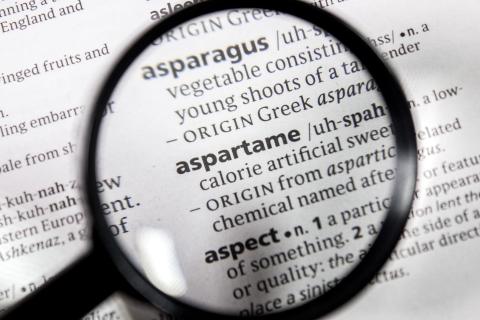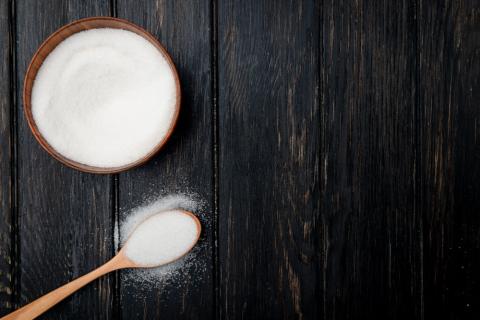Reactions: aspartame sweetener is classified as possibly carcinogenic to humans, although the acceptable daily intake remains unchanged
The International Agency for Research on Cancer (IARC) and the Joint FAO/WHO Expert Committee on Food Additives (JECFA) have published a health impact assessment of the sweetener aspartame. Citing "limited evidence" of carcinogenicity in humans, IARC has classified aspartame as possibly carcinogenic to humans (Group 2B). For its part, JECFA has not changed the acceptable daily intake of this sweetener, which is set at 40 mg/kg body weight. According to these bodies, with one can of diet soft drink containing 200-300 mg aspartame, a 70 kg adult would need to consume more than 9-14 cans per day to exceed the acceptable daily intake - assuming no other intake from other dietary sources.

Urrialde - Aspartamo (EN)
Rafael Urrialde de Andrés
Professor at the Faculty of Biological Sciences of the Complutense University of Madrid and at the Faculty of Pharmacy of the San Pablo-CEU University, and member of the Board of Directors of the Spanish Society of Nutrition
The WHO press conference on Wednesday 12 July, which I attended, could at the very least be classified as very surprising: different positions of IARC and JECFA on the scientific evidence, although in both cases they indicate that it is limited and not convincing. JECFA stresses that the evidence on cancer risk in animal and human studies is not convincing to establish a link between aspartame consumption and cancer.
Let us hope that the rest of the food safety and nutrition agencies and authorities of countries worldwide or regions such as the European Union also adopt positions that do not generate these scaremongering, clear and convincing risk assessments: the European Food Safety Authority, Food Drug Agency of the USA, Food Standards Agency of Australia New Zealand, Canadian Institute of Food Safety, Food Standards Agency of the UK, Norwegian Food Safety Authority, Icelandic Food and Veterinary Authority, Federal Food Safety and Veterinary Office of Switzerland, Comisión Federal para la Evaluación de Riesgos sanitarios de México, Canadian Institute of Food Safety, Food Safety Commission of Japan, etc.
In the 1990s, the constitution of food safety agencies was clearly requested to avoid what happened yesterday [at the press conference], in this case, with aspartame, because if it is classified as 2B, possibly carcinogenic by IARC, either the ADI [acceptable daily intake] is lowered by JECFA or it is withdrawn; if the ADI is maintained by JECFA and other food safety agencies and authorities worldwide due to lack of scientific evidence, alarmism should not be generated. I cannot imagine an institution such as the WHO saying that a drug poses a risk and the agencies or drug approval authorities saying otherwise, as they are the ones who really evaluate the safety and efficacy of drugs.
On the other hand, maintaining the ADI of 40 mg/kg person/day, this means a consumption of 2,800 mg of aspartame. The calculations given by the WHO at the press conference are surprising because, using food composition tables, it would not mean 10 cans of soft drink, as they said, but approximately 15, based on the premise of an amount of around 50 mg of aspartame per 100 ml of food product. Furthermore, with this ADI, I repeat that according to JEFCA it is not necessary to modify it, it could mean for a 70 kg adult to consume all of the following products in a single day: 2 servings of alcoholic mixed drinks, 8 teaspoons of cocoa powder, 2 low-calorie beers, 5 chewing gums, 5 teaspoons of table sweeteners, 2 servings of canned fruit or vegetables, 2 servings of sugar-free gelatine,3 yoghurts or fermented milks, 2 portions of jam, 2 glasses of nectars, 2 juice-based soft drinks, 3 portions of chocolate, 3 soft drinks with or without added sugars or added sugars, dabs of sauces, 2 tea drinks and 2 drinkable yoghurts.
However, it should be noted that at the press conference it was also stated, surprisingly, that for a child weighing 20 kg, the aspartame intake would be 800 mg. In this case, as in the case of pregnant women, elderly people or those who have a physiological problem or illness other than phenylketonuria and who should not consume aspartame because of the phenylalanine content, the WHO should be more cautious, If they are classifying it through the IARC as 2B (possibly carcinogenic), they should have indicated that children, as well as the aforementioned persons, should abstain from consuming aspartame, as the degree of protection, as also taken into account by the JEFCA for the determination of the IDAS, would be much higher. In this respect, it should also be pointed out that the data provided yesterday by the WHO were not in line with reality, as 800 mg of aspartame is not equivalent to 2-4 cans of soft drinks, but to 5-6 cans of soft drinks, or the equivalent of consuming the following products in one day: 2 yoghurts or fermented milks, 2 portions of chocolate, 5 teaspoons of cocoa powder, 2 portions of jam, 2 glasses of nectars and 2 glasses of fruit-based drinks.
It is essential to launch in vivo studies in humans and to clearly determine the degree of exposure to sweeteners in general and aspartame, sucralose and saccharin in particular, due to the risk of cancer or their possible impact on the intestinal microbiota.
On the other hand, it should be pointed out once again that low- or no-calorie sweeteners are additives that serve to reduce or eliminate the amount of sugar, but for the control and reduction of overweight and obesity, as well as other pathologies, the total diet should be taken into account, because a single food product or a single ingredient or additive can have its effect cancelled out by the effect of the other foods and drinks in the diet. Likewise, the use of low- or no-calorie sweeteners should not be generalised and should not start to be incorporated, as is being done, in food products that did not even have sugar before and to which now, for whatever reason, they want to give or add sweetness.
"From 1986 to 1992 I worked at the Faculty of Biological Sciences in the Chair of Plant Physiology as a collaborator and developing the work of my doctoral thesis. In 1991-1992 I worked as a Scientific Collaborator in the Plant Freezing Unit at the Cold Institute of the Spanish National Research Council (Consejo Superior de Investigaciones Científicas). From 1992 to 2000 I worked in a Consumers' Association, in the Spanish Consumers' Union and in the Revista de Consumo Ciudadano (edited by 5 consumer associations), where I was the Director of Food and Health and the Technical Director, respectively. From 2000 to 2006 I worked at Puleva as Director of Food Safety and Health. From 2006 to 2020 at Coca-Cola Iberia as Deputy Director of Scientific and Regulatory Affairs and later as Director of Nutrition and Health. Since 2020 I am Professor in different Faculties of different Universities: Faculty of Biology of the UCM, Faculty of Pharmacy of the USP CEU, Faculty of Nursing of the University of Valladolid and I collaborate in different masters in food, applied plant biology and food safety of the Faculty of Veterinary Medicine of the UCM, of the Faculties of the Campus of Health Sciences of the University of Barcelona, of the Faculty of Pharmacy of the University of Seville and of the Faculty of Pharmacy of the University of Granada. I am a Full Academician of the Royal European Academy of Doctors-RAED and member of its Governing Board and Honorary Academician of the Spanish Academy of Nutrition and Dietetics, President of the Scientific Committee of the Spanish Society of Sports Medicine and Member of the Board of Directors of the Spanish Society of Nutrition-SEÑ. I am also a member or partner of several scientific societies: Spanish Society of Food Safety-SESAL, Spanish Society of Community Nutrition-SENC, Spanish Academy of Nutrition and Dietetics-AEND, Spanish Society of Nutrition-SEÑ, Spanish Society of Sports Medicine and member of the Board of Trustees of the Spanish Nutrition Foundation-FEN. Since March 2020, I have no conflict of interest because I have no contractual relationship of any kind with any food company, neither in the food processing or distribution sector, nor with any pharmaceutical company. I have only collaborated with Consumer Associations and Scientific Societies or I am a member of the Scientific Advisory Committee in some information platforms".
Oliver Jones - aspartamo EN
Oliver Jones
Professor of Chemistry, RMIT University, Melbourne (Australia)
The IARC has made the assessment that leaked reports over the last few weeks suggested they would and classified aspartame as category 2b, the 2nd lowest level. This means there is insufficient evidence of a link. Other things in this category include mobile phone use and petrol engine exhaust fumes.
This is the first time that the IARC has looked at aspartame and seems to have been prompted by a paper that came out in 2022 that mentioned liver cancer. The IARC expert committee would have reviewed all the available literature when coming to this conclusion, but not done any new research themselves.
There are two terms we need to understand here. The first is ‘hazard’ which just means a possible harm (even if that harm would be very unlikely to occur), and ‘risk’ which is the likelihood of the harm occurring. Think of it like driving a car. There is definitely a hazard; cars crash, and people get injured, and even die, but the risk of that happening when you drive to the shops or take the kids to school is fairly low, most of us don’t think about it - even though the risk is not zero.
Now, the IARC only looks at hazard, which in this case means they just looked to see if there was any evidence that aspartame might be linked to cancer. They do not make an assessment of how likely the hazard is to occur.
The Joint FAO/WHO Expert Committee on Food Additives committee has not changed its safety rating on Aspartame which they set at about 40mg/kg body weight which for a 70 kg adult would mean drinking roughly 17 cans of Diet Coke a day, over a long period. This is consistent will all the major food safety agencies around the world who regularly conduct their own assessments and all classify aspartame as safe at the levels it is used at.
We should also remember that we all exposed to carcinogens every day. It sounds scary but its about risk. Even things that the IARC classifies as class one carcinogens, such as UV light and alcohol, do not cause cancer instantly just because you are exposed to them once. For example, if you get too much sun on the beach in summer you might get sunburn but you’ll recover. If you continually sunbathe with no sun protection then your risk of skin cancer goes up.
In short, I will continue to enjoy my Pepsi Max and I think you can too.
Gunter Kuhnle - aspartamo EN
Gunter Kuhnle
Professor of Nutrition and Food Science, University of Reading
The publication of the IARC and JECFA opinion is very welcome as it ends the speculation about the safety of Aspartame. The two WHO agencies have done what they are supposed to do: IARC has reviewed the data and found some very limited evidence that Aspartame could cause cancer – and based on the same data JECFA has concluded that a consumption up to 40 mg per kg of body weight per day is safe and there is no need to change current recommendations.
“It is unfortunate that leaking some information might have created unnecessary uncertainty and concern as consumers might be rightfully worried if they are told that something that is in many foods could cause cancer. The published opinion puts this into perspective and makes it very clear that there is no cause for concern when consumed at the current amounts. Scientific advisory bodies are often unable to react quickly and respond to an emerging story so it’s good they will now have both the IARC and JECFA assessments to digest and respond to.
“This illustrates also the importance of distinguishing between hazard and risk and highlights the difficulty in communicating hazards: sunlight is a hazard as it can cause cancer, but the risk depends on the amount of sun light and whether we use protection. Likewise, even if Aspartame causes cancer at very high amounts, there is no risk when consuming it at the amounts that are permitted in foods.
Teng - Aspartamo (EN)
Andrea Teng
Senior Research Fellow, Department of Public Health, University of Otago, New Zealand.
Aspartame has been classified as possibly carcinogenic to humans by the International Agency for Research on Cancer, World Health Organization.
That means its safety at current doses is not a major concern and we need to do more and better research to understand its effects. To put this in context, the evidence is stronger for the links between alcohol and cancer, or red meat and cancer.
Sugary drinks are the bigger problem. There is good evidence for an association of sugary drinks with diabetes, dental decay, and other chronic diseases. But they have not been reviewed by IARC.
The problem with studying diet drinks containing aspartame is that people may be selecting these products because they are already at high risk of nutrition related disease, and they want to reduce that risk. So it can be difficult to untangle these effects.
We need urgent action to improve our food environment in New Zealand.
Jones - Aspartamo (EN)
Alexandra Jones
Senior Research Fellow in Food Policy and Law at The George Institute for Global Health (Australia)
For current consumers of diet drinks, this news isn’t cause for major alarm. Aspartame has been classed in IARC’s Category 2B, which means there’s limited evidence that it might cause cancer, not that it does or is likely to. The work from JECFA confirms that normal levels of consumption appear to be safe.
Beyond this focus on aspartame and cancer specifically, we know the use of sweeteners in our food supply is increasing – in Australia for example, the food industry has been turning away from aspartame for some time, with more use of ‘natural’ sweeteners such as Stevia (cite). As governments and consumers have looked to reduce sugar intake, we’re seeing an increase in sweetener use across the food supply – not just in drinks. It's important that we continue to study the long-term effects of this on a range of health outcomes. Given other recent guidance from the World Health Organization that non-sugar sweeteners should not be used as a means of achieving weight control or reducing the risk of heart disease or diabetes, it might still be wise to think about the overall benefits to health (and your wallet) from trading a soft drink habit of any kind for healthier alternatives such as tap water.
Barclay - Aspartamo (EN)
Alan Barclay
Consultant dietician, nutritionist, chef, and honorary associate fellow at the University of Sydney (Australia)
IARC has re-analysed old studies and come to the conclusion that the intense sweetener aspartame is “possibly carcinogenic to humans” (Group 2B). The quality of evidence that underpins this assessment (mostly based on rodent studies) is not high and the conclusion can of course by challenged.
Regardless, like most things in life, dose matters. The JECFA have reaffirmed the Acceptable Daily Intake (ADI) of 40 mg/kg body weight per day which has been in place in Australia since aspartame was approved for use in foods and beverages in the 1980s. The most recent FSANZ diet exposure assessment determined that the the average Australian consumes less than 10% of the ADI and even the biggest consumers have less than 25% of the ADI
Since this survey was conducted, other intense sweeteners have been approved including “stevia” and “monk fruit”, and have been popular as they are perceived as more natural alternatives. Australian population intakes of aspartame are therefore well below the ADI, and likely to be decreasing due to the popularity of other alternatives. Therefore, even the most avid users are not likely to be at increased risk of cancer from aspartame in Australia.
Finally, to put the IARC conclusion into perspective, aspartame will be grouped with other Group 2B foods/additives like pickled (Asian) vegetables, the colour amaranth and preservative Butylated hydroxyanisole (BHA). However, processed meats like ham, bacon and hot dog sausages are classified as Group 1 carcinogens and red meat is classified as Group 2A, indicating that they represent a higher risk for consumers than aspartame.
Alan declares that he is a co-author of the book The Ultimate Guide to Sugars and Sweeteners



